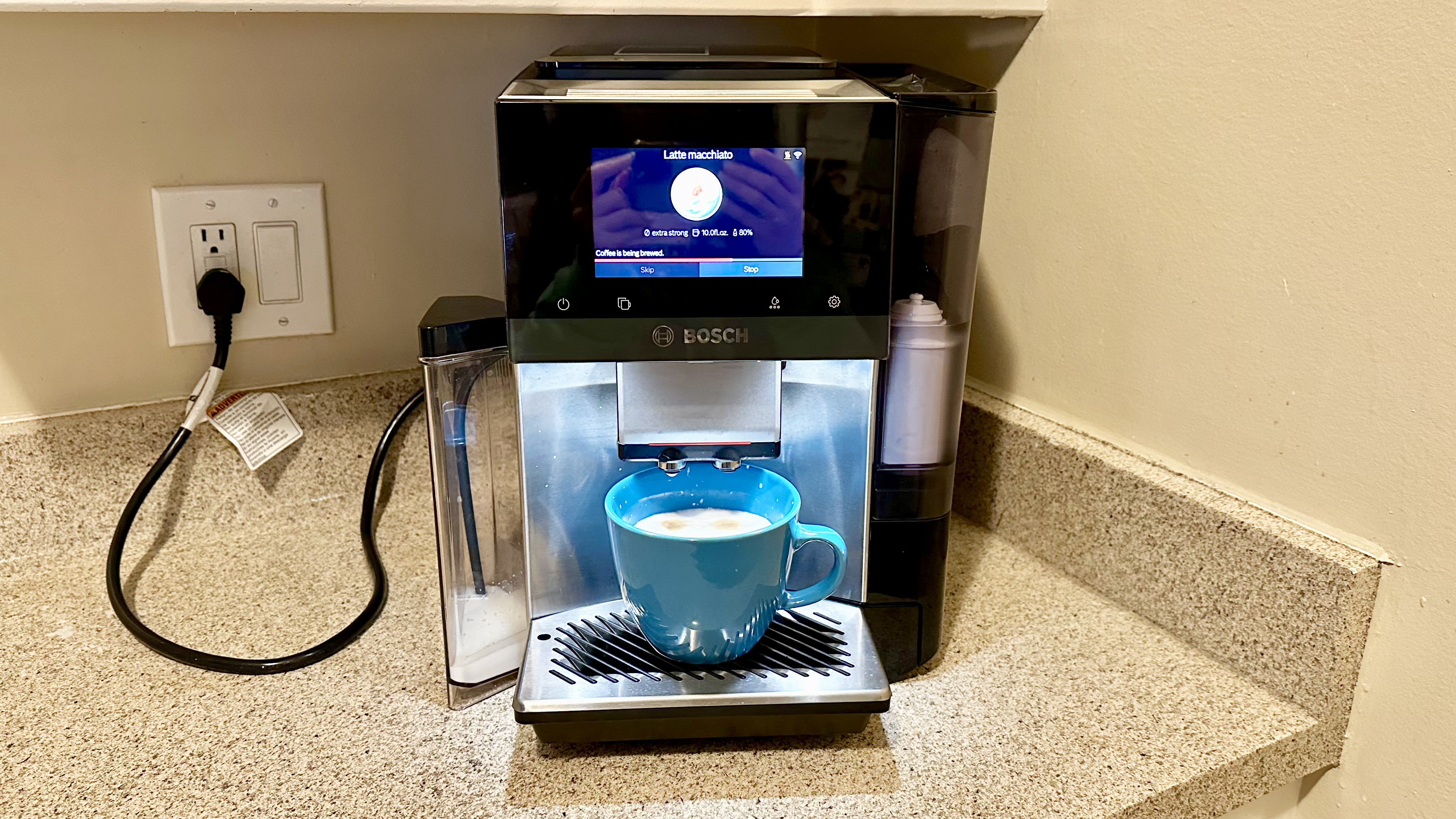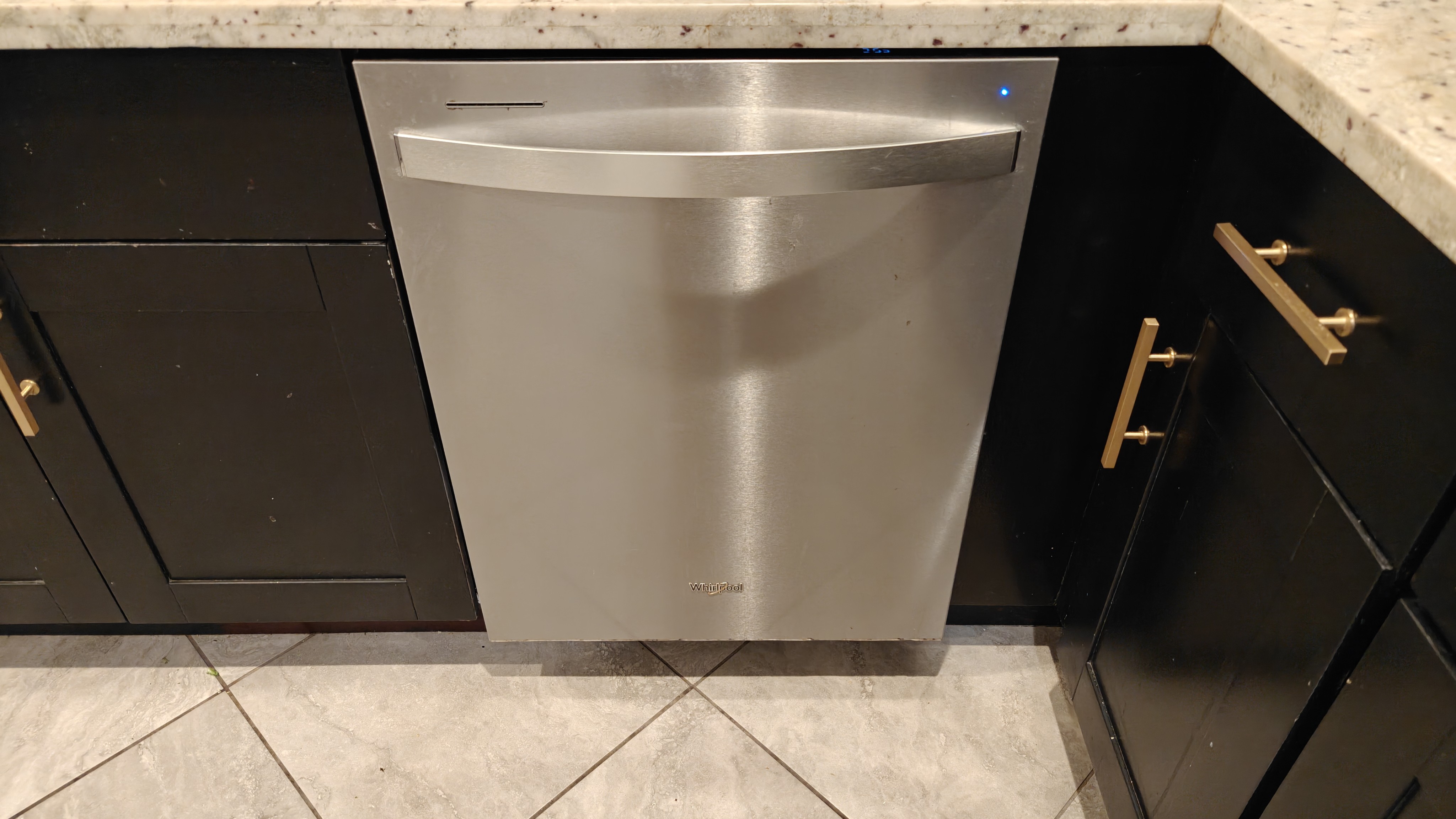Top Ten Reviews Verdict
The Bosch TQU60703 800 Series VeroCafe is a large but sleek bean-to-cup machine offering a wealth of features to make barista-style drinks at home with minimal effort and clean-up after. Its display is stunning and easy to navigate when selecting and customizing drinks. And if the espresso machine is connected to Wi-Fi, it can make up to 36 beverages, though many seem repetitive. But prepare for trial and error when finding and perfecting your favorite drinks, as many initial settings lacked flavor.
Pros
- +
Stunning, easy to use display
- +
Convenient self-cleaning milk system
- +
Remote control via app
- +
Brews drinks quickly with minimal effort
Cons
- -
Experimentation with customizations required to perfect many drinks
- -
The 36-drink option claim is a bit gimmicky
- -
Larger build
Why you can trust Top Ten Reviews
The Bosch TQU60703 800 Series VeroCafe Fully Automatic Espresso Machine is the top-of-the-line model of Bosch’s countertop fully automatic espresso machines. The German brand is known for making high-quality, long-lasting home appliances and has a few other espresso machines, including built-in options.
With the 800 Series comes the promise of consistently brewed barista-quality coffee and a host of features like a cup warmer, integrated milk system, and an intuitive display, so making your favorite drinks is as simple as can be. But does it deliver on its promises? After testing the bean-to-cup machine for the past few weeks, I've found that it keeps up with many of the best espresso machines I've previously tested. However, that’s not without a few flaws.
As soon as I rested my eyes on the Bosch TQU60703 800 Series VeroCafe, I was wowed by its sleek, larger build and stunning display that made it easy to scroll through various beverage options, from cappuccinos and latte macchiatos to pots of coffee and hot water. In total, when connected to WiFi, there are 36 different beverage options, though many of the drinks tasted quite similar and were hard to differentiate between. Still, I could customize each drink to suit my taste buds, which I needed to do for most, as many milk-based drinks lacked the rich coffee flavor with their initial settings. But with some trial and error, many drinks came out delicious.
Given that this machine is fully automatic, most of the time, I just had to press a few buttons for a freshly ground coffee-based drink in a couple of minutes or less. It even comes with app support to make drinks remotely, but I still preferred to use the touchscreen display. A few features, like the self-cleaning milk system and height-adjustable beverage dispensing unit, also made life even easier and kept clean up to a minimum.
Even with the $2,299.00 price tag, the Bosch 800 Series VeroCafe has the capabilities of fully automatic machines that are twice the cost, making it a great value. Keep reading to find out how I reached my verdict.

Danielle is a dedicated coffee lover who has experimented with various coffee makers, including Keurig, Bruvi, Ninja, Breville, Cuisinart, and Casabrews. She typically enjoys her daily coffee black, but occasionally indulges in iced vanilla lattes from local coffee shops. When she tried the Bosch 800 Series VeroCafe, she was impressed by its user-friendly design and customizable settings. After using it for nearly a month, she found that it surpassed her previous Ninja Luxe Café. Danielle appreciated the VeroCafe's wide range of drink options and its ability to brew coffee to her exact preferences.
Bosch TQU60703 800 Series VeroCafe: Key specs
| Row 0 - Cell 0 | Row 0 - Cell 1 |
| Model no. | TQU60703 |
| Type of coffee | Espresso |
| Number of drinls | 36 |
| Pressure | 19-bar |
| Grind settings | 6 |
| Brew time | 30 secs - 5+ minutes |
| Water tank | 81.2 oz |
| Milk container | 23.67 oz |
| Average noise level | 60dB |
| Power cord length | 39.38 in |
| Dimensions | 13.86 x 18.4 x 15 in (w x d x h) |
| Weight | 21 lbs |
Bosch TQU60703 800 Series VeroCafe: price & availability
The Bosch TQU60703 800 Series VeroCafe is available directly from Bosch with a retail price of $2,299.00 in the US. It can also be found in Amazon and Sur La Table retailers.
The 800 Series from Bosch has several models, and the one I reviewed, the TQU60703, is the most expensive and feature-rich. The lowest-cost model, the TPU60309, has an MSRP of $1,599.00, but it lacks the handy self-cleaning milk system, the cup warmer, the illuminated cup area, and a few other features. Two other 800 Series models are also available for less than my review model and have a few missing features. If you’re after a more “budget-friendly” fully automatic espresso machine from Bosch, check out the 300 Series lineup.
Sign up to receive the latest news, reviews, buying guides and deals direct to your inbox
When it comes to automatic espresso machines, the Bosch 800 Series Fully Automatic Espresso Machine VeroCafe is available for a mid-range price, despite the seemingly eye-watering cost to those unfamiliar with these types of coffee makers. However, given the wealth of drink options, built-in grinder, convenient milk system, easy maintenance, stunning display, remote control, and solid waste, it competes with high-end machines nearly double the price, like the JURA GIGA 10. Considering that, I’d say this machine is of good value. But if you’re willing to put in more effort, plenty of great semi-automatic espresso machines are available for a fraction of the cost.
Score: 4 out of 5
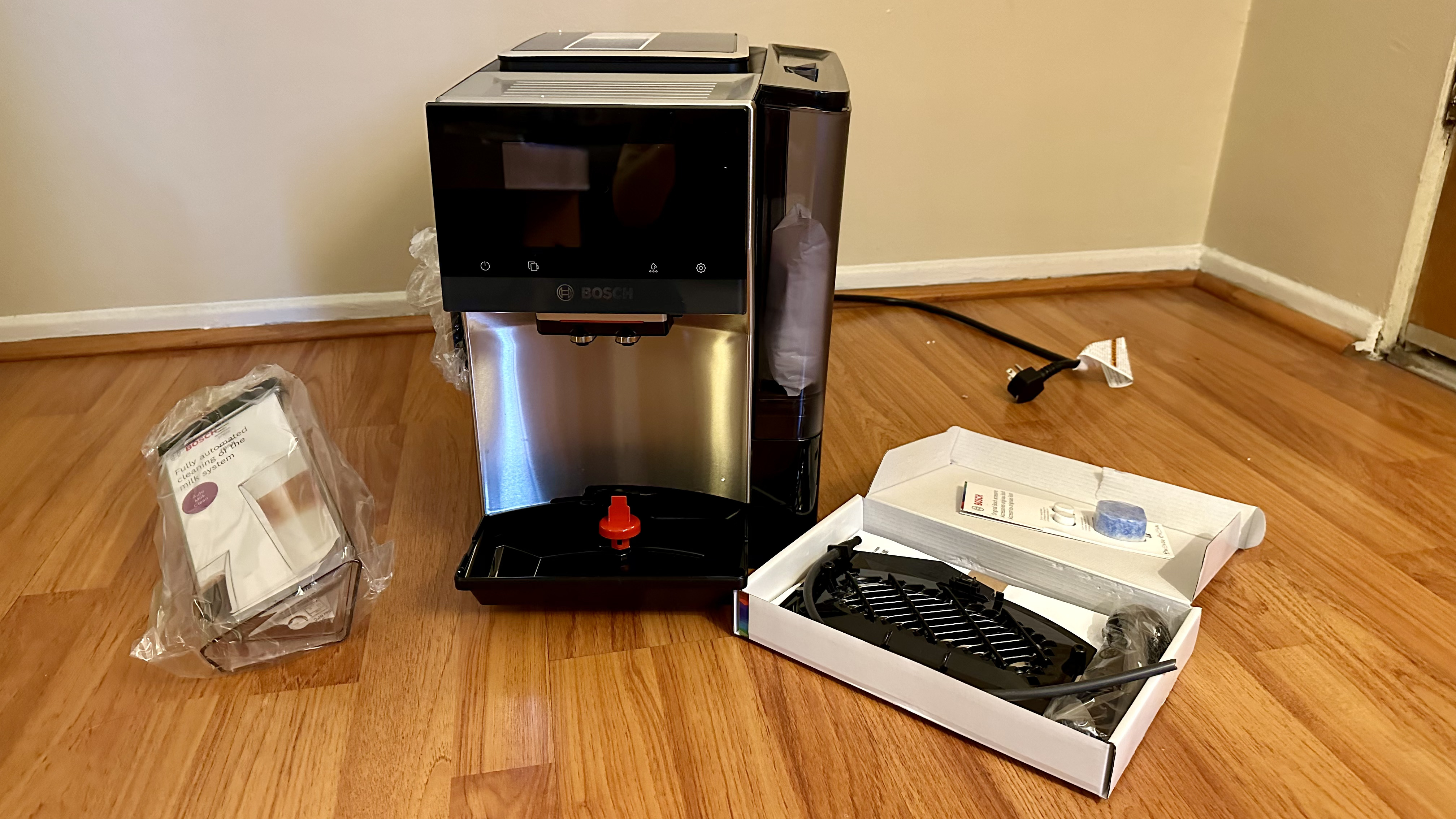
Bosch TQU60703 800 Series VeroCafe: Setup
The Bosch TQU60703 800 Series VeroCafe arrived in a large but manageable box that was slightly awkward to carry. Still, I got it inside with little issue. My excitement to try out this fully automatic espresso machine had been building for months after a shipping snafu, so I opened the box immediately. Inside, instructions to turn the box on its side greeted me, along with a smaller box and the milk container. I did exactly that and pulled out the espresso machine surrounded by styrofoam. More sustainable packing materials would’ve been a nice inclusion, but the use of styrofoam isn’t surprising.
When I removed all the packing materials from the machine’s body, it appeared almost fully assembled. The only items that weren’t attached were the milk container, the tubing for the integrated milk adapter, and the grate for the drip tray. Assembly looked minimal, so I hoped to get it up and running quickly. Unfortunately, I was sorely mistaken.
I’ve set up plenty of coffee makers over the past few years of reviewing, and the Bosch 800 Series VeroCafe takes the cake for being the most confusing and difficult to get up and running. The written instructions were convoluted, seemed to repeat steps, and made you do more work than was necessary. I struggled with following the written instructions throughout. However, the water hardness test – which other high-end espresso machines often include – never explained how to read the results. In the end, I think I did everything correctly, but I’m still not sure.
Luckily, plugging the machine eased the installation process, as following the stunning 5-inch LCD was much easier than figuring out what was happening in the manual. A quick cleaning and a few other setting adjustments were done quickly. I connected the espresso machine to WiFi via the Home Connect app on my phone in under 5 minutes, allowing me to make brews remotely. From start to finish, about an hour later, I was ready to brew my first drink.
When all was set up, the machine was absolutely stunning with its stainless steel and black finishes, but the standout feature was the ultra-sharp, full-color LCD touch display. Given the cost, it looks high-end and classy, which it should, and I felt strongly that it’d deliver some excellent espresso-based beverages.
Bosch TQU60703 800 Series VeroCafe: Design
The Bosch TQU60703 800 Series VeroCafe looks match its high price tag. Its body is made of solid black plastic with sleek stainless steel finishes that match perfectly in my kitchen. However, it’s quite bulky, measuring 13.86 x 18.4 x 15 inches (w x d x h), which is especially deep. Still, the machine easily fits on my counter under my low cabinets. What shocked me most, though, was how light Bosch managed to make it considering all the features it’s packing, weighing only 21 pounds. Still, given its sheer size, this isn’t the most fun coffee maker to move around. Keeping it in one place is your best bet.
The most striking aspect of this automatic espresso machine is the 5-inch TFT LCD full-color display. If it’s on, it demands your attention with its stunning, clear picture displaying all the different drinks the Bosch 800 Series VeroCafe is capable of creating. In total, there are 36 drink options when connected to Wi-Fi, without internet you’re limited to 11. Still, all the basics are covered, from a traditional espresso and coffee to classic coffeehouse staples like a cappuccino, caffe latte, and latte macchiatos. A few milk and water options are also mixed in.
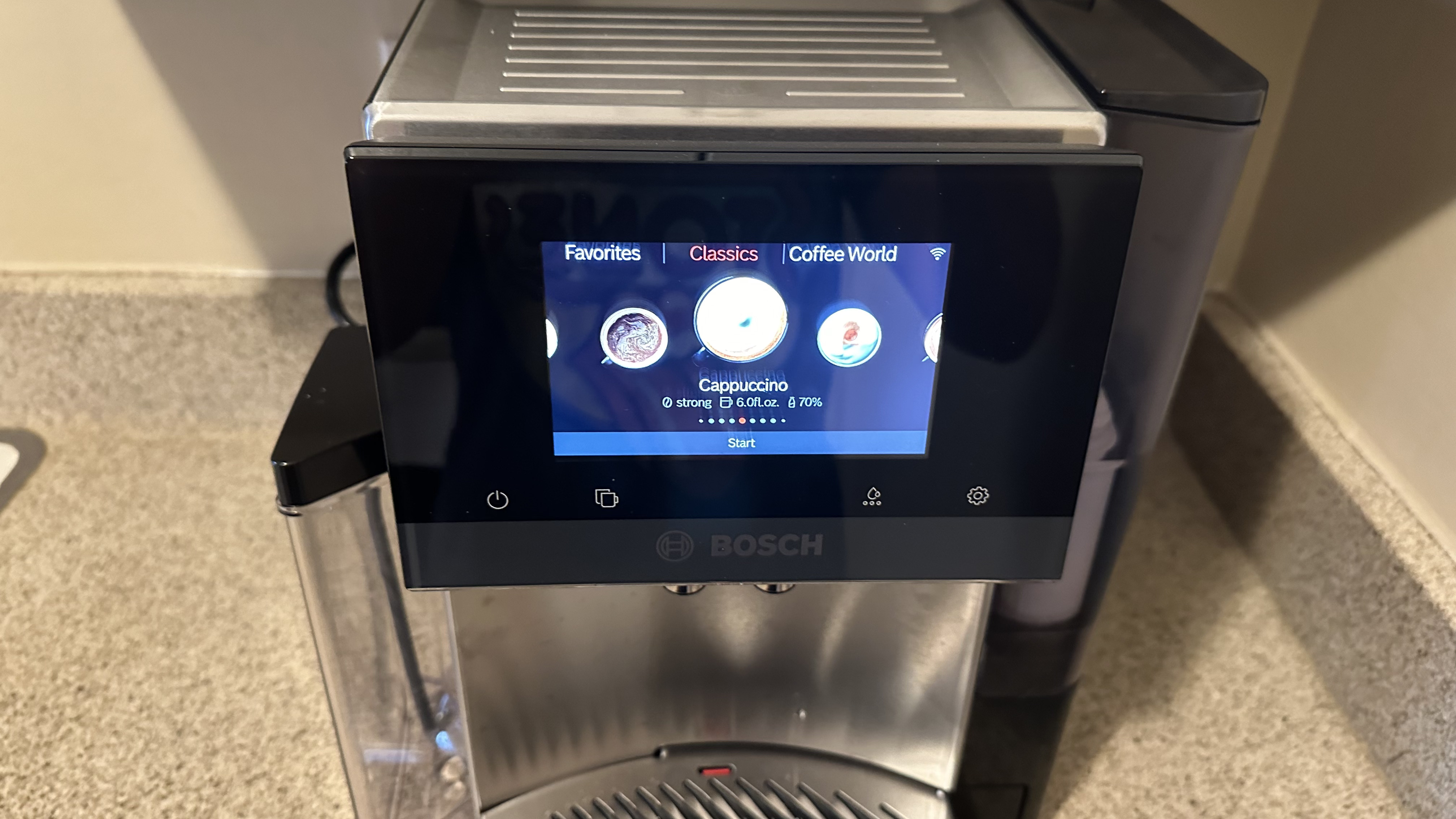
With touch sensitivity, scrolling through all the different coffee drinks was a breeze, and I could make certain customizations to each drink with just a tap. Bosch even makes things a little bit easier, as in addition to the power button, there are a few more buttons, including the one-touch double cup control to make two drinks simultaneously, a button that takes you to cleaning and maintenance, and a final one that brings you to settings. It’s a nice added convenience.
Just under the display are a few LEDs that light up when the machine turns on and is brewing a drink. Does it serve a real purpose? I don’t think so, but it certainly looks cool. That’s also where the beverage dispenser is located. It has two different spouts, allowing for two drinks to be made simultaneously. It’s even possible to smoothly slide the whole dispensing mechanism up and down depending on the size of the drink vessel to prevent splashes. I especially loved that feature. Just don’t expect to fit larger travel mugs under the spout, as the drip tray can’t be removed when brewing a beverage.
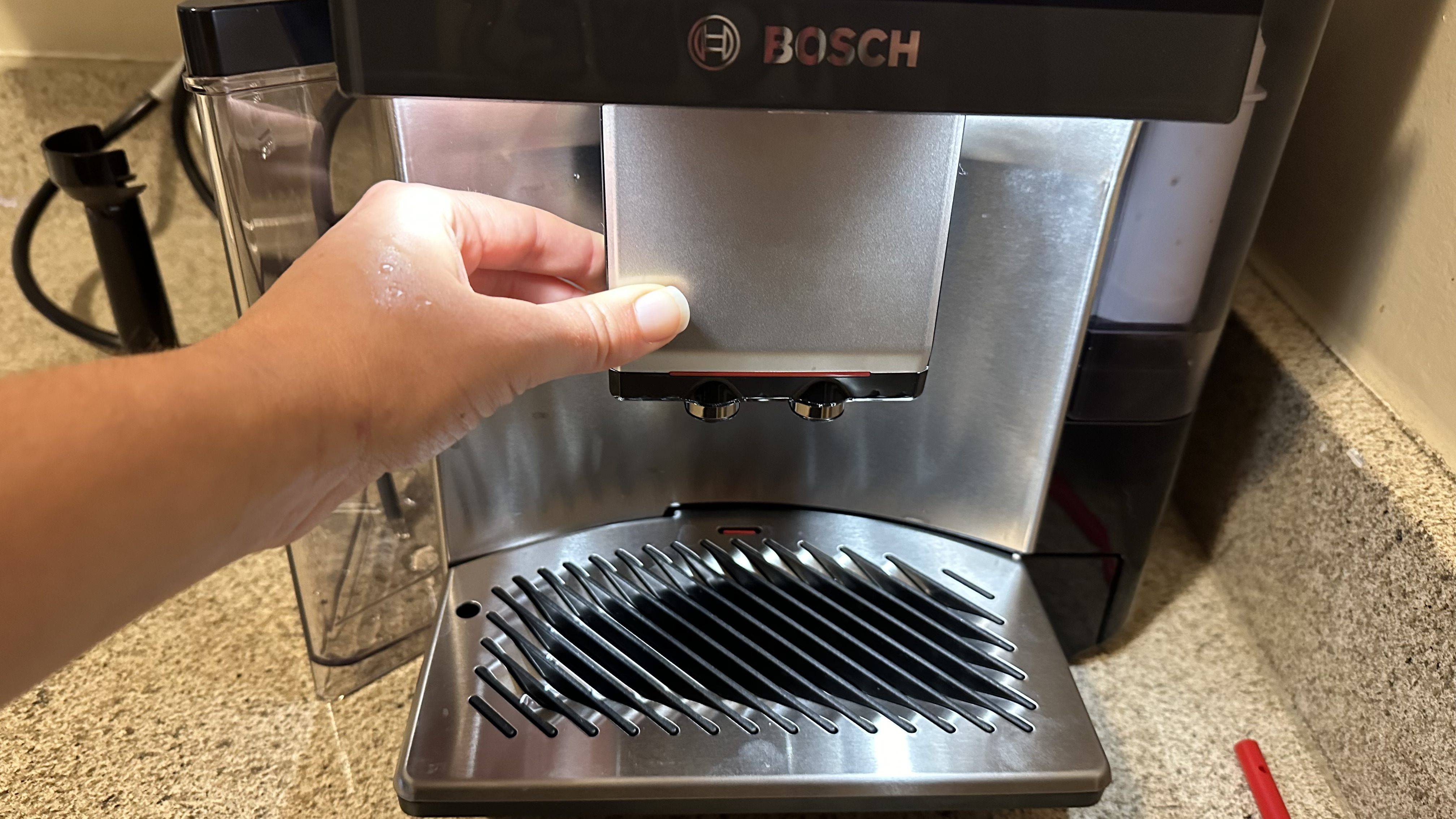
Speaking of the drip tray, it appears to be smaller than other bean-to-cup machines that I’ve tested. This is a slight annoyance because every time you turn on or off the machine, a rinse cycle occurs, which causes the drip tray to fill quickly. Runoff from different brews means it needs to be emptied fairly regularly. However, the drip tray also connects to the handy basket for used coffee grind pucks, making them super easy to toss out occasionally.
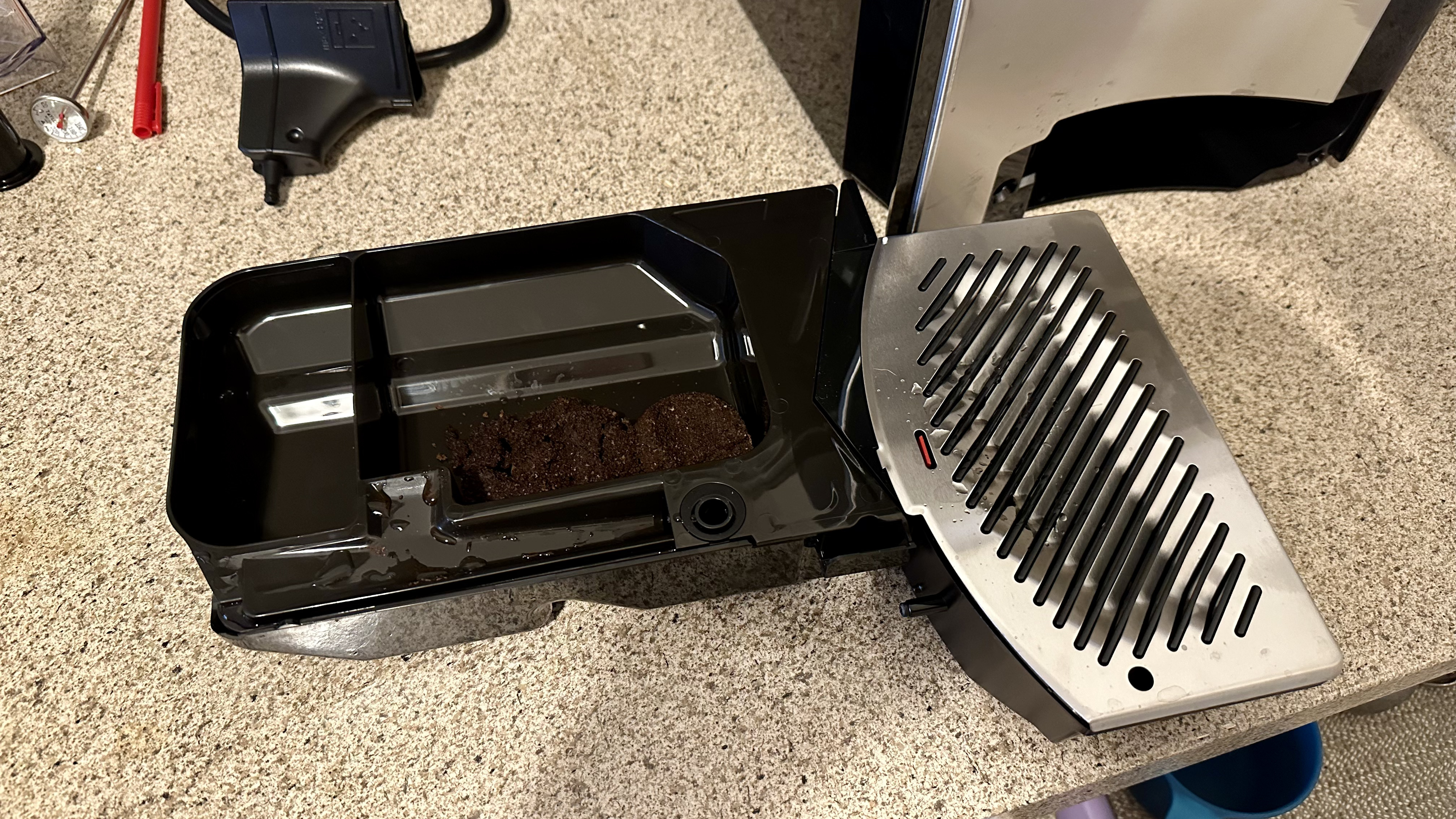
The removable plastic water reservoir is 81.2 oz – a nice size that doesn’t need to be refilled often. I love that Bosch placed the reservoir on the side of the coffee maker rather than the back for easier access, and it has a handle that made refilling less of a task. The 800 Series model I received also came with a water filter, which helped remove any impurities – a blessing for someone who lives in Los Angeles with its notoriously poor water quality.
The bean hopper and ceramic grinder are at the back of the machine. Where I have the Bosch 800 Series VeroCafe placed in my kitchen meant I had to move the entire body forward anytime I needed to fill the bean hopper up with new beans. Luckily, almost an entire bag of beans will fit in the hooper. The grind size adjustments are also inside the hopper, and there are unclear instructions on adjusting the grind level based on the bean type on the hopper lid. With only six grind levels, it's far less than many of the bean-to-cup machines I’ve used. I would’ve loved it if the machine had adjusted the grind size or had precise recommendations based on the current beans. I recently tested a machine that did this, and it consistently pulled perfect espresso shots.
With the bean hopper at the back of the machine, some space was left at the front that Bosch didn’t waste. So, a cup warmer is up there to warm mugs before a brew. I rarely used this feature, but it was a nice inclusion.
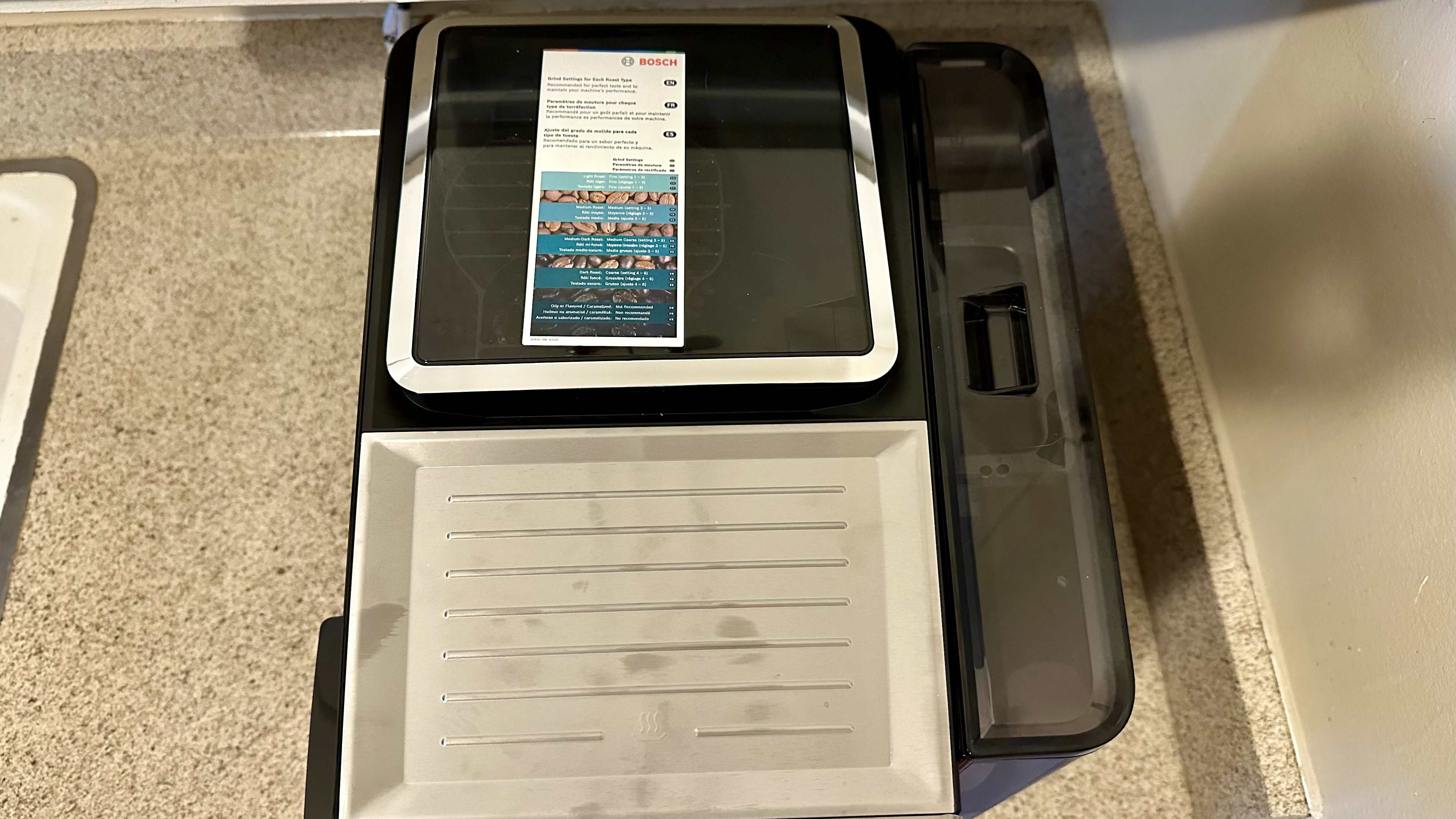
Finally, given that this machine can make specialty coffeehouse-style beverages that require milk, it offers a milk system. A 23.67-oz milk container could be filled with milk and stored in the fridge between brews or the milk container adapter to get milk directly from the carton. Both easily detach from the machine and can’t be installed when brewing water. If you’re making many beverages one after another, these options are super convenient.
Design: 4.5 out of 5
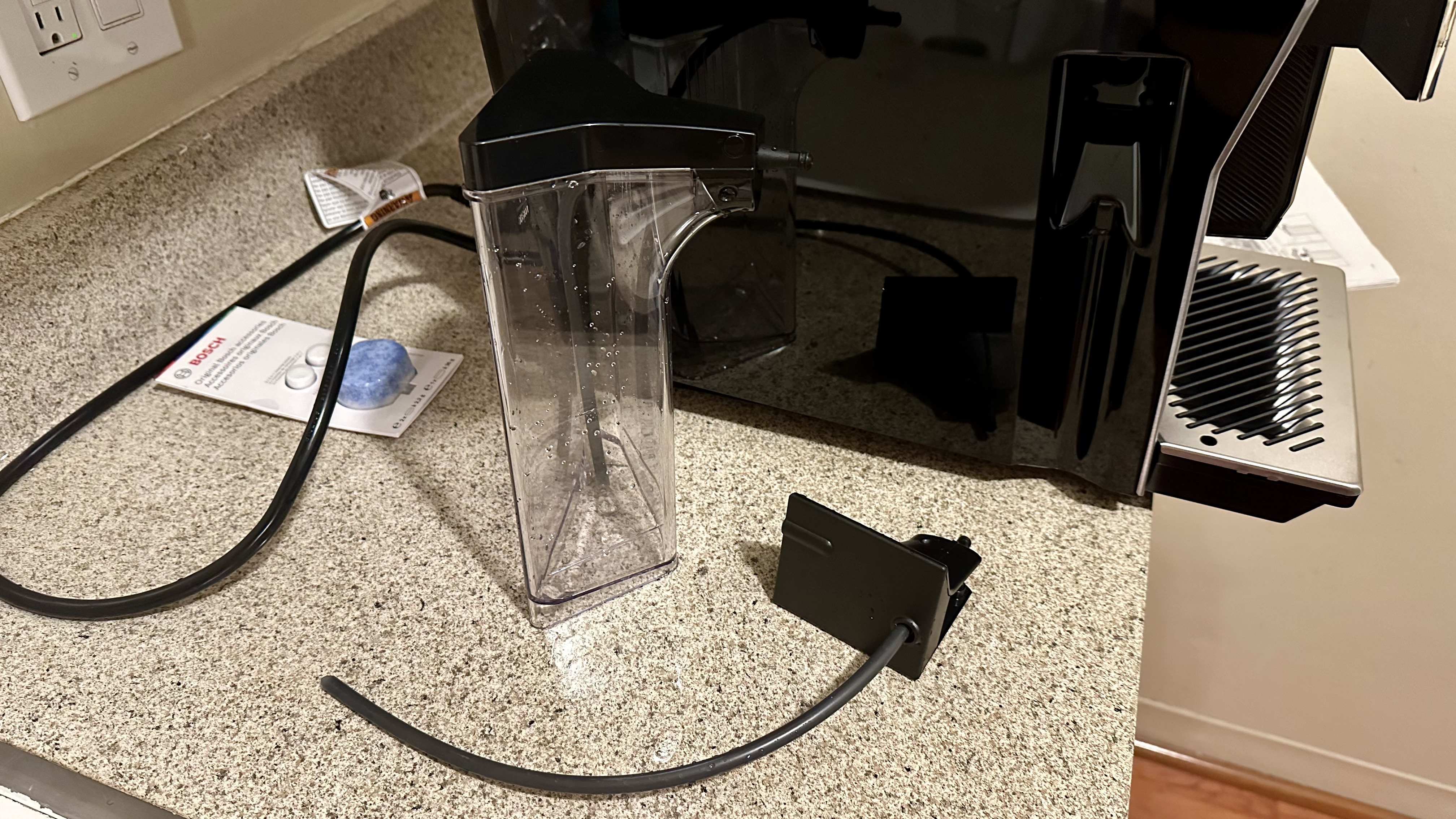
Bosch TQU60703 800 Series VeroCafe: Performance
After dealing with the slightly complicated setup, it was time to put the 800 Series VeroCafe to the test to see if it “consistently brewed barista-quality coffee,” as Bosch claims. So, I filled the removable water tank to the max line and loaded the bean hopper with fresh beans to get started.
When the machine was turned on, a rinse cycle was automatically performed, which took about a minute. This rinse will happen every time it powers on. Once finished, the display greeted me with a wide selection of beverage options, including espresso, espresso doppio, cappuccino, latte macchiato, hot milk, hot water, and more. It was easy enough to scroll through the options, and each included a photo to give you an idea of what the drink was like.
Now, that’s just the start of the drink options, as when you’re connected to the Wi-Fi, a world of other beverage options are available via the CoffeeWorld tab on the touch screen, including cortados, flat whites, americanos, and more. In total, Bosch claims there are 36 different drink options. However, after testing, I found many of these drinks are redundant and more of a gimmick than anything else. But I love that a description and an image representing the country the drink is from is in the background when you select a drink in the CoffeWorld section, like the Sydney Opera House for Australia or the Golden Gate Bridge for the USA. And scrolling through these beverages is just as easy as the main coffee options.
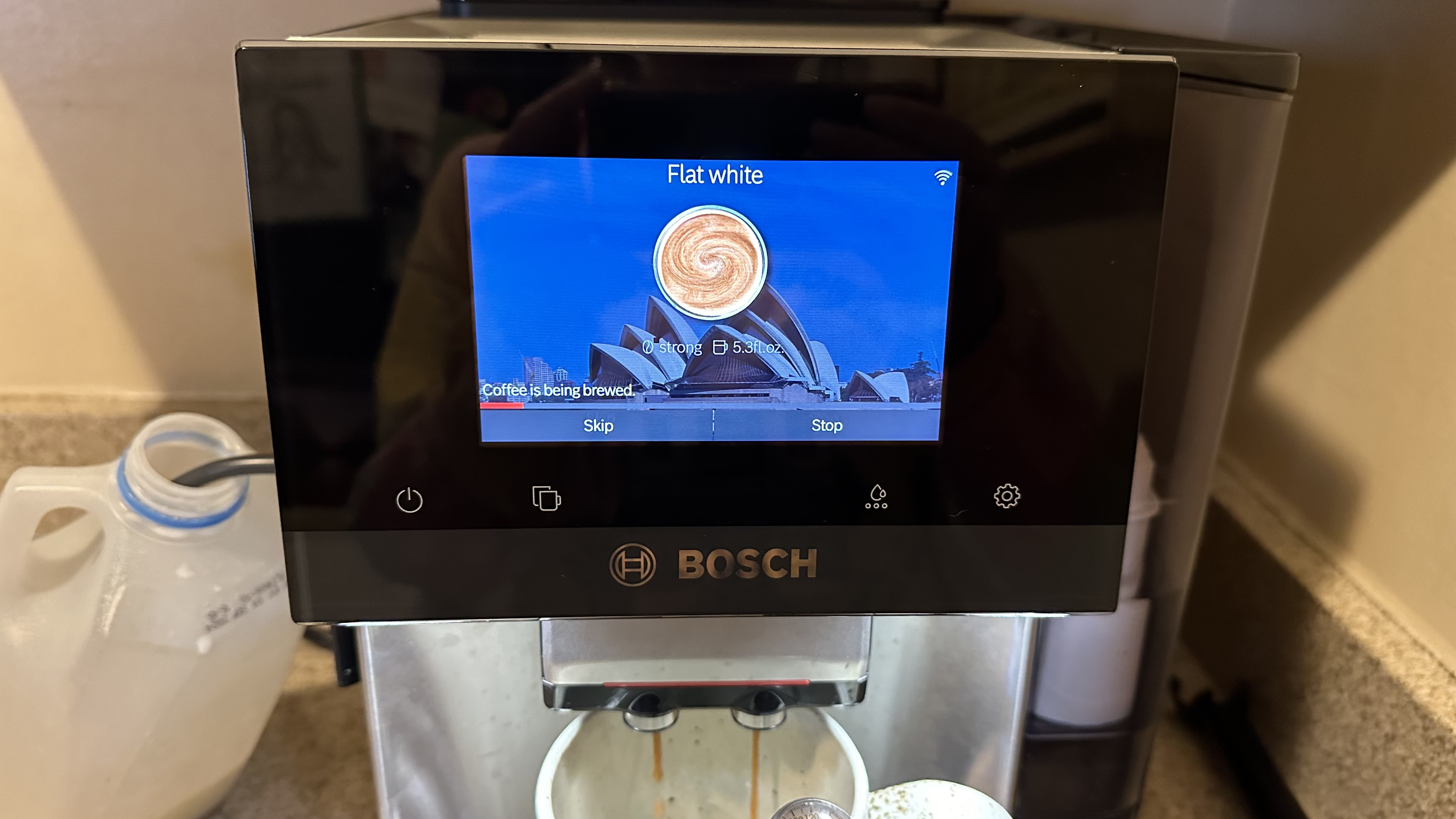
Almost every beverage can be customized to a certain degree, allowing me to change the size, strength, amount of milk, and the “Aroma,” depending on the drink. Bosch offers a unique Aroma Max System. Little is mentioned about how it works, but when it came to brewing, I could choose between three different Aroma profiles: mild, balanced, and distinctive. After selecting all the preferences, the drink could be saved to favorites – another tab on the touchscreen. It made it simple to access your favorite top beverages with their ideal settings already saved.
With so many drinks and customization options, it was a little overwhelming, and that’s coming from someone who’s tested her fair share of bean-to-cup machines. I’d imagine it’s even harder to wrap your head around if you're a novice. Luckily, after playing around with the machine for a few weeks, I could dial in how I preferred my drinks and narrow down my favorites to go back to. That ended up being the espresso, latte macchiato, and cappuccino – the classics.
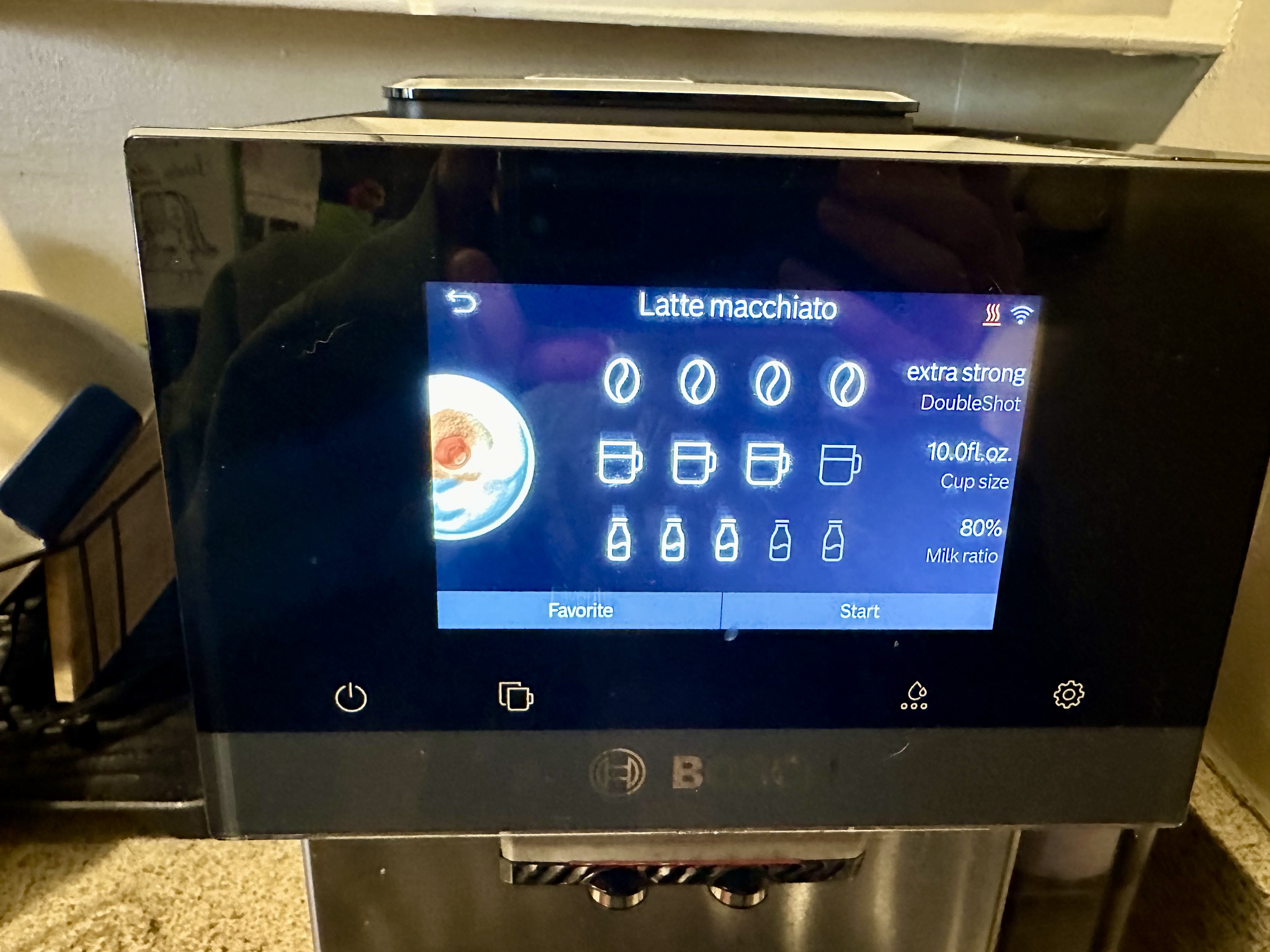
For my first drink in the Bosch TQU60703 800 Series VeroCafe, I decided to keep it simple and brew an espresso, leaving the settings as is. Since my small espresso cup, I moved the beverage dispensing unit down to prevent spills. It worked like a charm, with no coffee splashes on the machine’s body. When I pressed start, the LEDs illuminated the brewing area – a nice, high-end touch. During the brewing, I could hear the beans being freshly ground and the machine working its magic. After about 30 seconds, I had a fresh, warm 110°F espresso. That’s not the ideal temperature, but the change could be due to the vessel and time. This was all with little effort, especially since I didn’t need to deal with portafilter.
Beyond espresso, I also brewed a bunch of coffee drinks that didn’t involve milk, including an espresso doppio, americano, coffee XL, and cold brew. Each was just as simple to make as the espresso. All I had to do was adjust the settings to my liking and press start. I even made a 25 oz pot of coffee. It's also capable of dispensing hot water, though if you make it after coffee it may come with a slight aftertaste. Still, water temperature adjustments can be made, so I often opted for the hottest setting to make tea. It’d also be great for instant ramen.
Of course, the Bosch 800 Series VeroCafe also makes tons of milk-based coffee drinks, of which I tried the majority. Making a drink with milk was more involved, as either the milk container or the milk adapter needed to be installed. Doing this takes all of 20 seconds at most. I usually gravitated to the milk adapter over the milk container when brewing since clean-up was a little easier. I realized after the fact you can store the milk container in the fridge and pop it into the machine when you’re ready to make a drink. Still, no matter which way I chose to dispense the milk, the results were always the same.
During brewing, the milk and froth were dispensed from the same place as the coffee, so I never had to worry about moving the cup to a different location for the milk, as some machines require. After setting up the milk adapter and placing my vessel of choice under the beverage dispenser, I followed almost the same extract process as the non-milk-based coffee drinks. The only difference was selecting the milk percentage I wanted in my beverage. Then I just pressed start, and the espresso machine did the rest. I had flat whites, cappuccinos, and latte macchiatos in one to two minutes. It was quite impressive how quickly the drinks came together, all with a temperature of about 120°F.
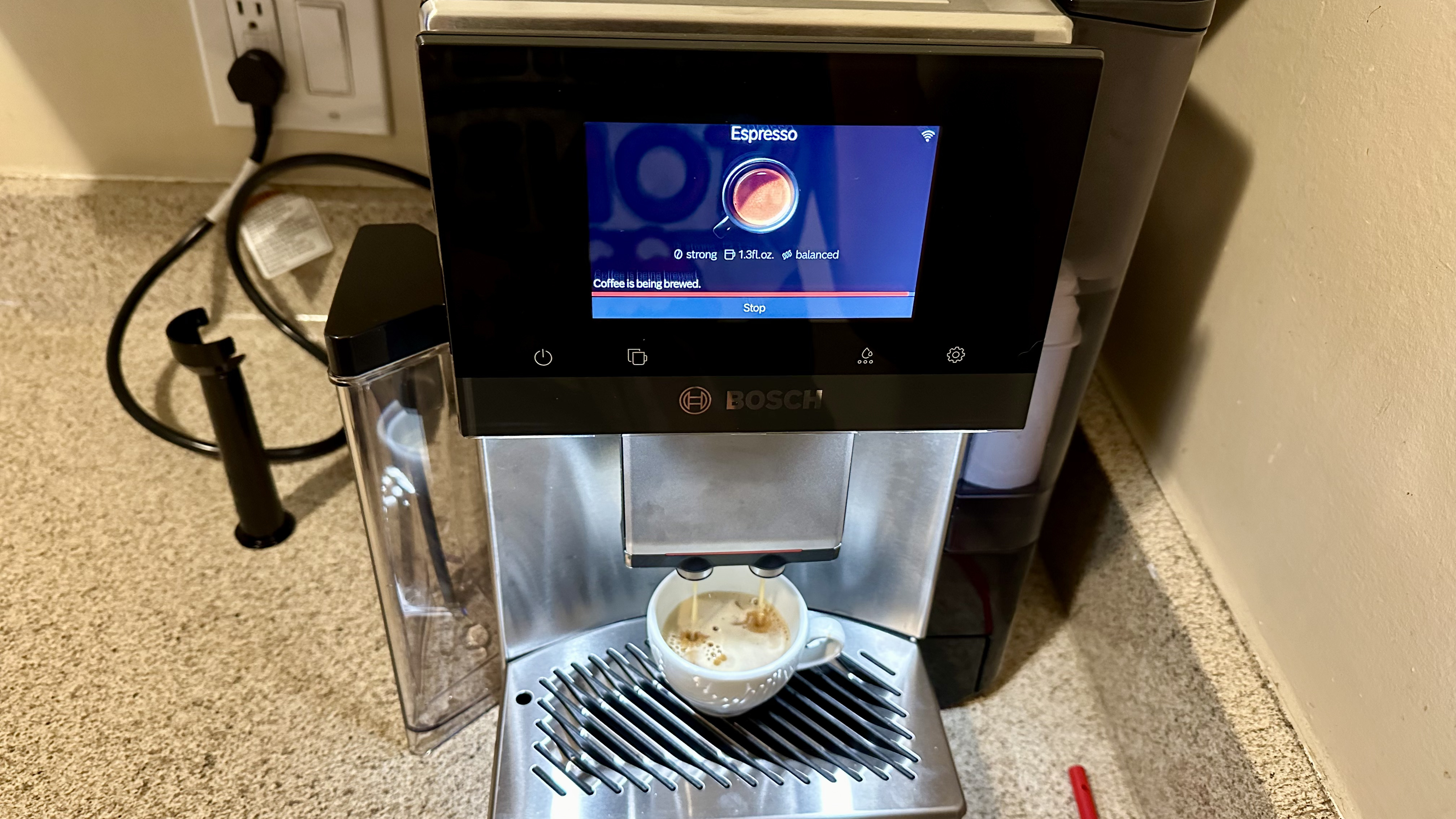
No matter what drink was brewed, the machine kept quiet, hitting a maximum of 60 dB. That’s similar to a dishwasher, so I wouldn’t be worried about it waking others in your household if you’re after an early morning caffeine fix.
Once the drinks were finished brewing, the milk system had automatic cleaning to make maintenance a breeze. It uses steam to clean after every drink, helping longevity and saving time.
The milk's texture should change depending on your selected drink type. Some drinks just had warm milk, while others had different froth textures. But during my actual brewing of drinks, it only seemed like fluffy froth or warm milk was the option – a noticeable flaw in drinks like flat whites. This isn’t an unexpected disappointment, as automatic espresso machines can only do so much. That’s where manual frothing is handy. Making a nice microfoam perfectly suits the drink, but this machine doesn’t offer that option.
During testing, I used 2% milk and oat milk. Plant-based milk tends to struggle with frothing more than dairy. Still, when I made an oat milk cappuccino, a good amount of foam formed, which I wasn’t expecting. Sure, the oat milk didn't get as fluffy or last as long as the 2% milk, but it still worked.
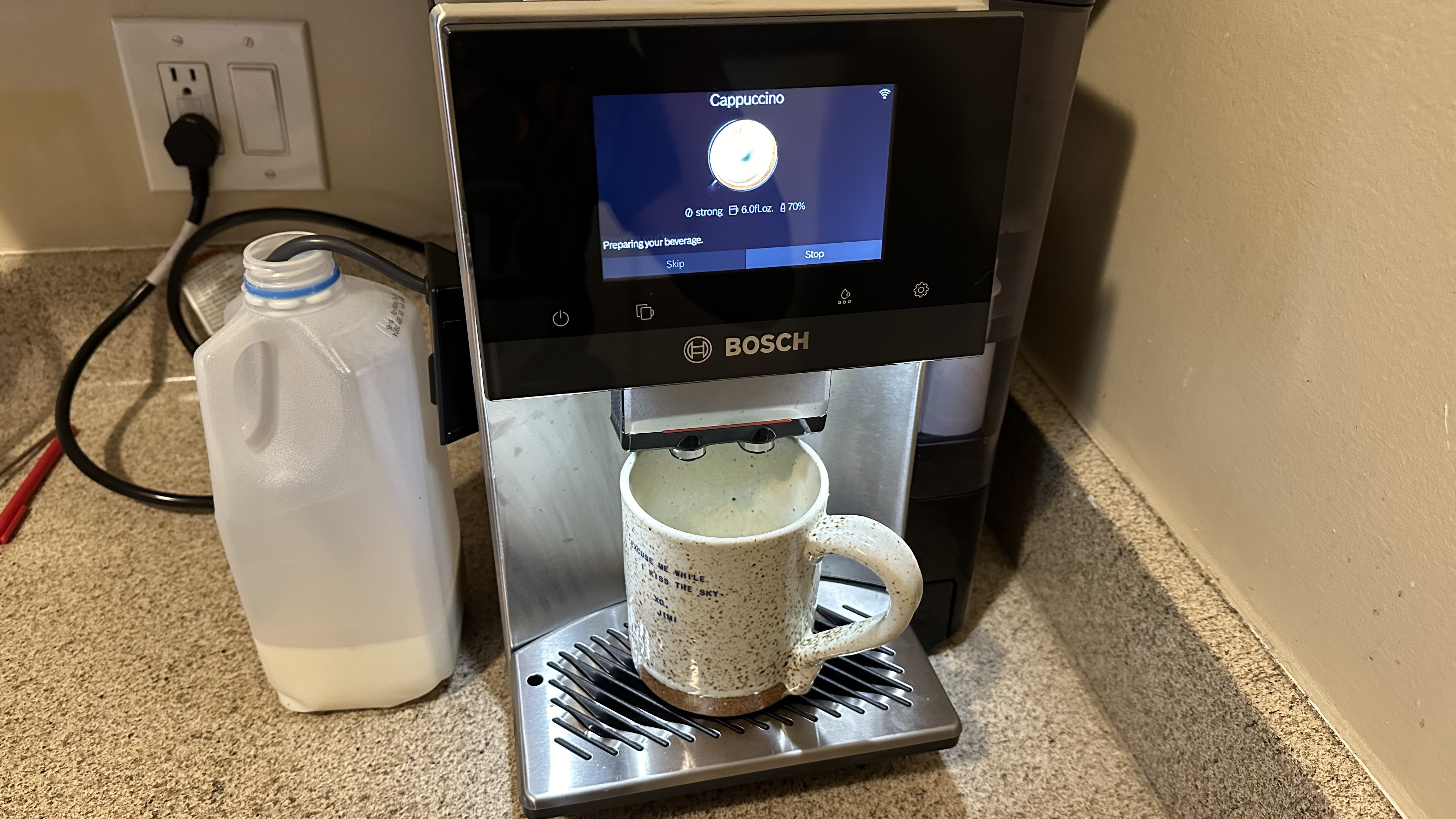
In addition to using the LCD to select and brew beverages, I could do it remotely using the Home Connect App. I preferred the touch screen, as the app was a little more complicated to navigate and didn’t display images of the drinks. Luckily, you can still make all the same drink adjustments as the LCD, and it even has a cool function called a Coffee Playlist to make a bunch of different beverages one after the other. It’s a nice feature for a small office or when you have visitors over. It can even make two drinks simultaneously, though they must be the same. There’s also a button on the machine itself to do this. Voice control is available with Alexa and Google Home, so you don’t need to lift a finger for a fresh cup of coffee.
The app is the only place I could figure out how to turn on the cup warmer at the top of the machine. I only used the feature several times, as it only warms the cups when the espresso machine is on. Like most people, I usually turned on the machine when I was ready to brew a beverage, leaving little time for the cup to warm up. And by the time I was ready for my second drink, the machine had already shut itself off. I found the whole thing pointless, though it did make my espresso warmer by about 10°F when I took the time to let my cup warm up.
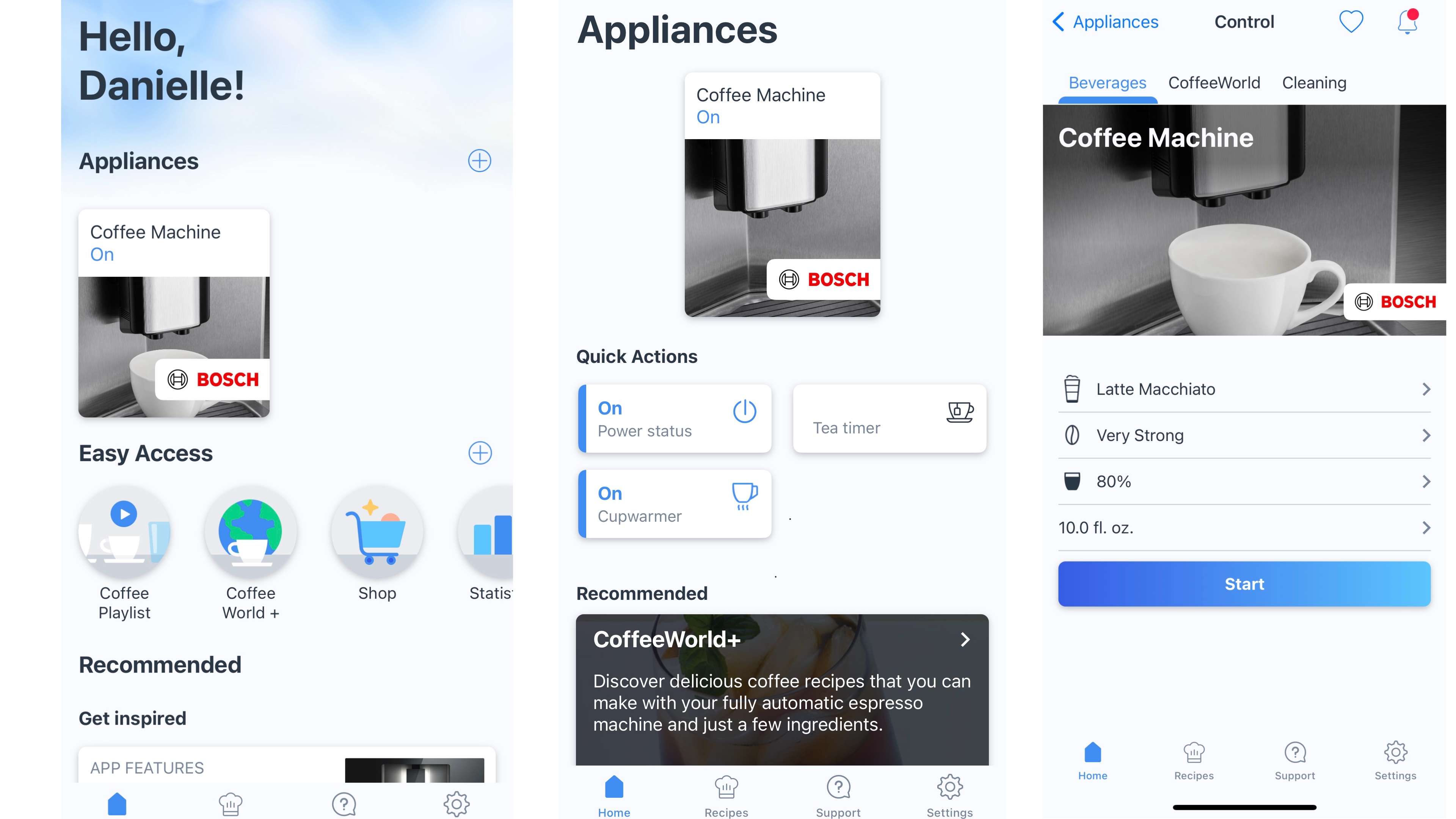
Maintaining the Bosch TQU60703 800 Series VeroCafe is on par with many other bean-to-cup coffee makers I’ve used. There are your typical requirements, like emptying the drip tray, which I found more cumbersome than normal due to the drip tray’s smaller size and the machine’s on/off rinse cycles. The LCD lets you know when this needs to happen. However, you never need to worry about emptying a portafilter like a semi-automatic espresso machine. Instead, a basket holds a good amount of used coffee grinds. I had to empty it less than once a week while making two to three daily beverages.
Beyond that, filling the water reservoir and bean hopper were occasionally required, and the machine will warn you when this needs to happen. Of course, wipe-downs of the body also occurred to keep it looking good.
If you notice a dip in performance or after you’ve brewed a certain amount of drinks, more thorough cleanings will need to be done. The control panel and the app have an entire section dedicated to this. There’s even a countdown to tell you when cleanings like descaling or replacing the water filter must happen. Even after weeks of testing, I was still far from needing to perform any of these cleaning tasks, but the LCD will walk you through the process when it needs to happen.
Score: 4 out of 5
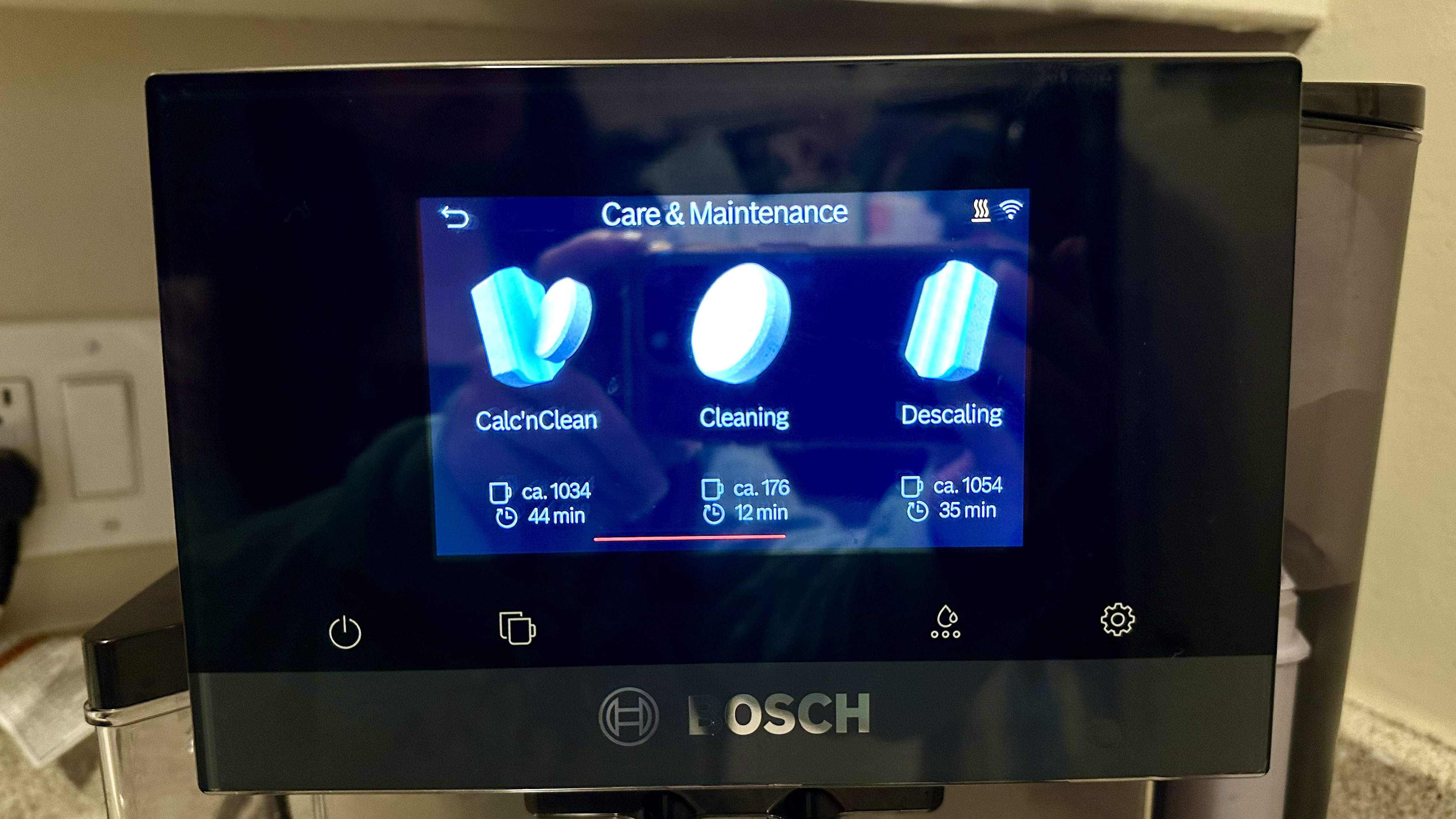
Bosch TQU60703 800 Series VeroCafe: Taste test
Perhaps most important is how the coffee tastes. Given that the Bosch TQU60703 800 Series VeroCafe freshly grinds beans and has a 19-bar pressure system, I was hopeful that each drink would be fresh, rich, and flavorful. It was a hit or miss in testing, depending on the beverage settings.
Buying Guides
Best pod coffee makers: for great coffee with no mess and no fuss, tried and tested
Reviews
Casabrews 5700Pro Espresso Machine review: an all-in-one espresso machine with a learning curve
Jura E8 review: the best-selling bean-to-cup coffee maker from the brand
De'Longhi TrueBrew Drip Coffee Maker review: truly a marvelous brewing experience
De'Longhi Eletta Explore review: a bean-to-cup coffee maker with hot and cold brew options
L’OR Barista Coffee & Espresso System review: espresso shot or cup of coffee?
The first drink I made was just a regular espresso. Bosch warns you that the first few drinks won’t be a true representation of what the machine can do, and with watery results the first few pulls, I hoped things would improve. Luckily, finagling the grind size delivered better results. However, the crema wasn’t the rich, golden color I had been accustomed to, and the shot didn’t have the bold, slightly acidic flavor I love. Eventually, after switching beans, the pulls started to have a golden crema and well-balanced acidity that went down smoothly. It just took a lot of trial and error to get there.
Beyond a regular espresso shot, I made a bunch of espresso and coffee brews sans milk. An americano is usually my go-to drink in the morning, and I found this one lacked a strong flavor. Many coffee brews, like the coffee grande and coffee pot, had a similar problem. Some even tasted a bit burned. The drinks also formed a crema, which isn’t normally the case when making a typical drip coffee. Maybe changing to a larger grind size would’ve yielded better results for the coffee brews.
Of course, most want this machine for the convenience of the one-touch milk-based beverages, and I was pleasantly surprised by just how easy it was to enjoy these drinks. Still, it doesn’t compete with the drinks created by skilled baristas at a good coffee house. Like my espresso, it took some testing to figure out my preferred settings. I found that almost all the milk-based drinks needed to have the strongest coffee setting to taste the coffee through the milk, making everything at least a double shot. This was the case for flat whites, cappuccinos, and latte macchiatos. After that, each drink was rich and flavorful with a lovely foam layer on top. However, it was hard to differentiate between many drinks, as you can’t adjust the microfoam level.
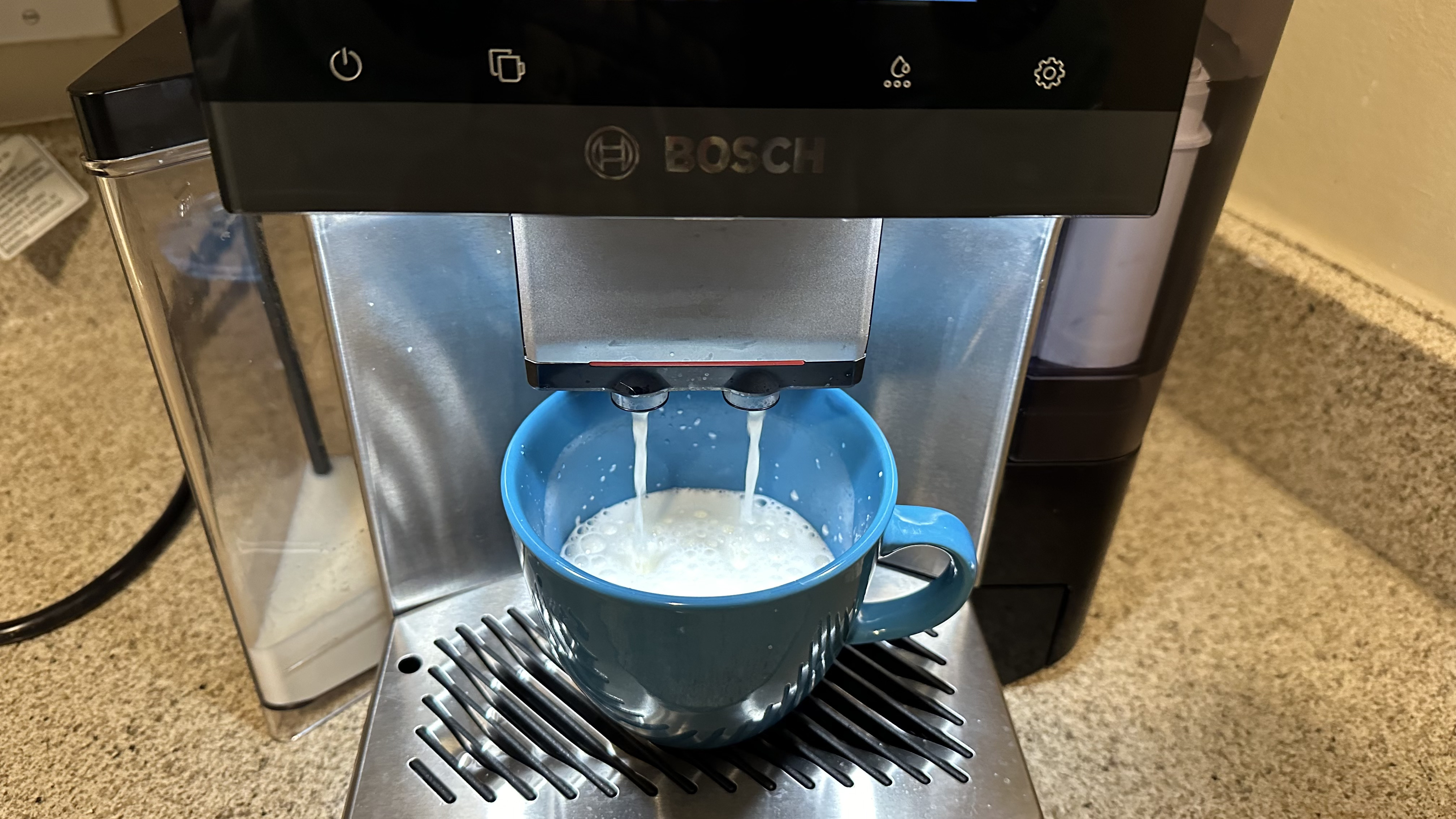
A few drinks, even with the double shot of espresso, just didn’t cut it and were undrinkable, tasting far too watered down. It turned out that most of the undrinkable culprits had only warmed milk with no foam, like the caffe latte and cortado. But the problem also could’ve just been my taste preference or the type of milk I used (2% and oat).
With some setting adjustments, many of the drinks were delicious and insanely convenient. My favorites were the espresso, latte macchiato, and cappuccino, but I tried some other great ones along the way.
Score: 3.5 out of 5
Should you buy the Bosch TQU60703 800 Series VeroCafe?
| Attribute | Notes | Score |
|---|---|---|
| Price & availability | An expensive option that’s a a good value for a fully automatic espresso machine thanks to its wealth of features. | 4/5 |
| Design | Offering a sleek, sturdy build, a stunning 5-inch touch display, and a handful of helpful design features, this machine nears perfection with only a few slight faults. | 4.5/5 |
| Performance | The espresso machine can be a little overwhelming but makes drinks with little effort using a handy touchscreen or app while maintenance is on par with other bean-to-cup machines. | 4/5 |
| Taste test | Drinks were a hit-or-miss and took trial and error to yield great tasting results. | 3.5/5 |
Buy it if...
You want a hands-off machine
This machine has almost everything automatic, so you only need to select the type of coffee you’d like brewed, fill the water, milk, or bean container, and empty the drip tray.
You love versatility
When connected to Wi-Fi, this espresso machine can brew over 35 drinks, including flat whites, americanos, lattes, and more. Plus, you can customize these beverages to a certain degree.
You want remote control
Unlike most espresso machines, this one offers app control to brew coffee from just about anywhere. You can even queue up drinks to have one brewed right after the other.
Don't buy it if...
You enjoy manually making drinks
The Bosch TQU60703 800 Series VeroCafe is fully automatic, leaving you little to no control over the espresso-pulling and milk-steaming process. The most you can do is minimally adjust the coffee grind size and slightly adjust the amount of milk in drinks.
You want the best-tasting espresso
Though the espresso is good, the pulls often lack the body and golden crema other machines succeed at.
You’re on a budget
Sure, this isn’t the most expensive machine out there, but there are plenty of other options, including ones from Bosch, that cost far less with great results.
How does the Bosch 800 Series VeroCafe compare?
The Bosch 800 Series VeroCafe is a highly capable and versatile full automatic espresso machine, but if you want something that takes it to the extreme, check out the JURA GIGA 10. Unlike the single touch screen on Bosch’s offering, JURA’s has three to make selecting and customizing drinks that much easier. It also has two grinders with automatic adjustments – something the 800 series lacks. However, other than that, the two espresso machines appear to be very similar with their dual dispensing spouts and 35+ drinks options, though the JURA GIGA 10 will set you back $2,000 more.
Sure, an automatic espresso machine like Bosch 800 Series VeroCafe is nice for those who want barista-style drinks quickly with minimal effort. But if you’re willing to put in more work, you can save a lot of money by grabbing the semi-automatic Breville Barista Express Impress. It freshly grinds beans and even helps you perfect your espresso pull with intelligent dosing. A manual milk steamer is also included to make lattes and cappuccinos. However, experiments will need to be done to achieve a great microfoam. Still, for a fraction of the cost, it might be worth the sacrifice, as after a bit of trial and error, the results can be just as great as the Bosch 800 Series.
Don’t want to deal with beans or adjust the ground level that’s required on the Bosch 800 Series VeroCafe? The Nespresso Vertuo Creatista uses pods instead and includes an integrated milk frother to make milk-based drinks. That frother can even froth the milk between three milk temperatures and textures, meaning you can make a variety of drinks with very minimal effort, just like the Bosch 800 Series. The coffee won’t be as fresh as a bean-to-cup machine, but it’s still mighty tasty, considering it’ll cost about $1,500 less.
How I tested the Bosch TQU60703 800 Series VeroCafe Fully Automatic Espresso Machine VeroCafe TQU60703
I used the Bosch TQU60703 800 Series VeroCafe in my home for several weeks, making two to three espresso-based beverages in the machine daily. I’d also play around with espresso and milk volumes to perfect my drinks. Ultimately, I tried a good portion of the 36 different drinks available. Beyond taste testing, I measured the temperature, noise level, and time it took to brew and observed the cleaning process. Quality coffee beans from Stumptown and Blue Bottle were used during my time with the machine to see if the results differed.
Read more about how we test.
- First reviewed: September 2024

Danielle Abraham, a Public Relations and Advertising graduate from the Rochester Institute of Technology, specializes in reviewing robot vacuums and coffee makers for Top Ten Reviews. Her work has been featured in top publications like IGN and TechRadar. She enjoys reading, watching documentaries, and hiking in Los Angeles and New York in her free time.
